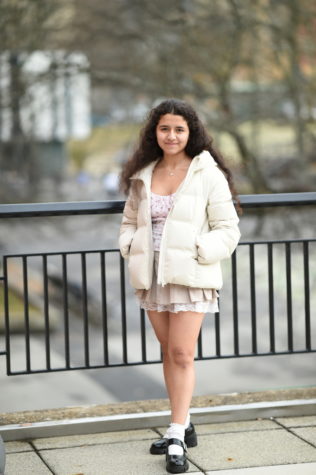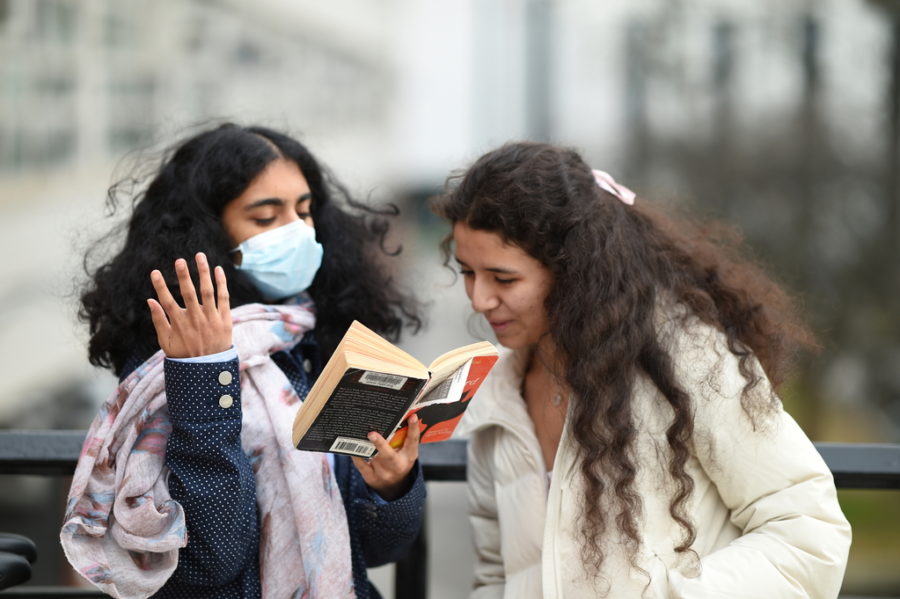A Love Letter to Romantic Academia
Romantic academia was born during the 2010s. A decade later, it is seeping into the mainstream by morphing into a full-fledged community worldwide. Why is Gen Z determined to have the aesthetic enjoy a glorious renaissance?
Kathleen Espinoza ’25 (right) and Amy Sooraj ’25 (left) chat over “I Know Why the Caged Bird Sings” by Maya Angelou. They both appreciate how romantic academia gives them the motivation to be better students, especially in their studying habits. For them, romanticizing aspects of the mundane make it oddly enjoyable.
It is exactly 11:11 p.m., and you find yourself in a dilemma. Your bedroom is pitch black except for a harsh, white glow from your laptop, illuminating your misery-stricken face. You are tired, angry, and confused, and feel anything but inspired. You refuse to look at the horrid screen displaying the essay assigned, empty except for a dark and flickering vertical line. It taunts you with its blinking, urging you to type in 500 words that cannot seem to form inside your head.
Dejected, you retreat into your colossal ivory-white comforter and decide to forget about it. But first: music. The waltz from Tchaikovsky’s The Sleeping Beauty begins to play, and it only takes a few seconds for you to sink deeper into your comfortable fortress with closed eyes to savor each note.
Physically, you are a high school student playing hide-and-go-seek with your English essay. But in the inner expanses of your mind, you waltz with a lover, Tchaikovsky playing faintly in the background. The two of you are alone in your castle, hidden in the woods, with green moss creeping up the walls. Amidst the whirlwind of intertwined hands, crescendos from the orchestra, and one-two-three-fours, inspiration finally strikes. And you write as you have never written before.
Only romantic academia can transform an English essay into a relentless enemy solely defeated by fantasized romance and Tchaikovsky. At its core, romantic academia is a visual style that meshes the pleasure of learning with Romanticism, an 18th-century movement that embraces spontaneity, passion, and love. Many novels published during the period, such as Mary Shelley’s Frankenstein, notably incorporate many of its beliefs: the celebration of intense feelings, an internalized reflection of self, and the rejection of rationalism over emotions.
Romantic academia also stresses the feeling of being in love, though not necessarily with someone else. Chandeliers, flower bouquets, and old books are frequent visuals within the aesthetic, as well as fashion staples like loafers, turtlenecks, and sheer black tights.
During the pandemic, an unprecedented number of people embraced romantic academia as their new style. In Tumblr’s 2021 Year of Review, romantic academia was the eighth most popular aesthetic on the site, 32 spots higher than the year before. On Pinterest, a quick search of the visual style instantly results in thousands of boards. And on TikTok, clips hashtagged #romanticacademia amassed around 18 million views — and counting — in total.
The rejuvenation of the visual style can be accredited to Generation Z, the generation of youth born between 1997 to 2012. They’ve managed to transform an offshoot of the overarching academic aesthetic into a distinct and diverse community full of aesthetes who adore fantasizing enemies-to-lovers scenarios, binge-watching the Harry Potter series, and worshiping Rory Gilmore.
But why does Gen Z feel compelled to launch romantic academia to new heights?
According to students here at Bronx Science, the aesthetic is the perfect balance between dark and light academia, two other styles that originated from the academic aesthetic. “I like aspects of both light and dark academia, but in romantic academia, you can incorporate more color and glamorize things more in a way,” said Kathleen Espinoza ’25. Both light and dark academia revolve around a general passion for knowledge. However, dark academia embraces the mystery of schooling through an intense fascination with criminality and tragedy while light academia embodies the optimism of student life by emphasizing sunshine and friendship.
Romantic academia effectively weaves in aspects from both aesthetic extremes while maintaining its individuality. For instance, it grants aesthetes permission to sulk over a breakup for one weekend and to imagine running through a meadow of wildflowers with their celebrity infatuation the next. The acceptance of both negative and positive emotions makes the visual style “much less ‘binary,’ per se, than light and dark academia,” said Kayla Owusu ’25.

Students also appreciate how romantic academia gives them the motivation to become better students. Though it is obvious that the visual style has an emphasis on the pursuit of intelligence, research, and scholarship, it transforms the perceived formidable nature of academia into something inviting and inspirational.
For students, romantic academia’s extravagance makes studying more compelling. “Studying regularly isn’t very fun,” said Espinoza, “but when you can romanticize parts of it, it becomes more enjoyable.” Across the board, the aesthetic’s ability to make the mundane aspects of life appealing, such as completing schoolwork, has been its focal charm.
Romantic academia encourages students to enjoy putting effort into their studies, whether it means wearing fashionable silk, satin, and lace ensembles to turn a seven-hour school day into a fashion show, or reading in relaxing cafes while enjoying a perfect cup of rich, dark coffee to keep study sessions exciting. It urges its enthusiasts to become ideal scholars by finding joy in the little things: reading a novel on the train, practicing calligraphy for hand-written letters, or listening to Tchaikovsky while typing an English essay.

“When I dress in a certain aesthetic like romantic academia, I feel better about myself and my capabilities as a student,” said Amy Sooraj ’25. “I feel like romantic academia has a huge connection with literature and art, two things that I enjoy very much as a student.” Other students shared similar thoughts, with some crediting the visual style as their reason for reading classic literature.
Literature is one element deeply embedded within romantic academia because it serves as a tangible expression of its ideas. Classics like Jane Austen’s Pride and Prejudice and William Shakespeare’s Romeo and Juliet explore the complexity of love by structuring it around a plot full of memorable characters that are still adored centuries later. But, with the help of the steadily-growing TikTok sub-community called BookTok, more teens are falling in love with reading again by adding contemporary novels to the romantic academia bookshelf.
The Love Hypothesis, an academic romance centered around a third-year Ph.D. candidate and a professor, gained substantial attention among romantic academia enthusiasts on BookTok in 2021, being named Amazon’s Best Romance Novel of 2021 and getting a nomination for a Goodreads Choice Award. Thanks to social media communities like BookTok, romantic academia surpasses the limits of a strictly-visual style by inspiring daily activities like reading. A common visual within the aesthetic — intellectuals chatting over their poetry dabbles — resembles Bronx Science’s Book Club, where Owusu participates as Event Coordinator. “[Romantic academia] reminds me of romance books which I love reading,” said Owusu.
Romantic academia is a culmination of things, differing with each person. Some admire the glamor and femininity of the style. Others cherish romantic literature and fashion. But for all the young people who sit hunched over their smartphones scrolling through Pinterest for inspiration on trendy trench coat outfits or browsing libraries for hours looking for the perfect edition of A Picture of Dorian Grey, romantic academia gives them a sense of belonging, a new identity, a little at a time.
Though it is obvious that the visual style has an emphasis on unification under the pursuit of intelligence, research, and scholarship, it transforms the perceived formidable nature of academia into something inviting and inspirational.
Grace Djabre is a Sports Editor for ‘The Science Survey.’ To her, the most effective journalistic writing can excite readers yet inform them with a...











